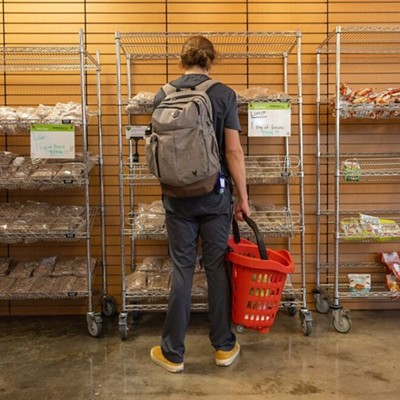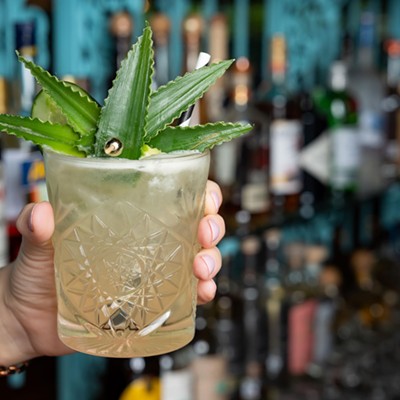In the days after Harvey the world (well, the Internet anyway) was getting to know Houston native Raz Halili. The 30-year-old oysterman was rescuing people from the flooded San Leon area in a boat with his cousin when a selfie he snapped went viral on social media. It was shared more than 7,000 times, and by at least one local television news outlet, with the hashtag he’d acquired alongside it, #rescuebae. But Halili, who helps run his family’s Galveston Bay-based oyster company, Prestige Oysters, was also dealing with a larger personal crisis. The private oyster beds they lease from the state in Galveston Bay, were being inundated with an unprecedented amount of fresh water in which bivalves cannot survive.
“The loss will be in the millions of dollars,” Halili tells the Houston Press. “It could be a $10 million hit. If you have no boats working at all, yeah, it’s devastating. It’s a punch in the gut.”
And for most oyster men and women right now, there are no boats working. The Texas Department of State Health Services has closed down the bay due to risk of bacteria—during severe rain falls, the health department usually steps in and closes shellfish classification areas (or conditionally approves them) in order to protect the public from fecal coliform bacteria often caused by run off from land. Open oyster fishing season begins on November 1, but Texas Parks & Wildlife will decide in the next week or so just what public grounds, if any, can be fished.
For oyster companies that tend the private reefs like the Halili family, acquiring permits to get in the water to check on their own reefs is vital. “Unfortunately it looks like the higher side of 80 percent of oysters are dying,” Halili says. “We’ve been out there, pulling up the dredge. I grabbed a handful that survived out of a hundred.”
Some private companies are hiring biologists from as far away as Los Angeles to aid in the sampling of beds, according to Lance Robinson of Texas Parks & Wildlife, and for good reason. Private companies account for 30 percent of production in Galveston Bay, owning leases to 43 private beds, which range from 11 to 100 acres. There are about 2,300 acres of private beds in Texas, all in Galveston Bay, which along with public beds, account for about a third of all the state's oyster production.
Jim Gossen, a longtime oystermen, Gulf Coast fishing advocate and founder of Louisiana Foods believes some oysters will survive as well, but also says that the industry is planning for the worst. “In some ways that amount of fresh water, a purge, is good for the health of the bay,” Gossen says, as it flushes out disease and predators, “but it’s bad for oysters.”
Oysters thrive in brackish water. When the water is around 15 points over a thousand salinity, the bivalves flourish. Anything saltier, and disease and predators, including parasites and an incredibly pesky snail, are known to become invasive. Anything below 8 points over 1,000 salinity and oysters will only survive a few days. During Hurricane Harvey, an estimated 51-inches of rain water flooded Houston, the run off eventually making its way to the bay. While the state health commission hasn’t released any hard data yet, the estimate is that salinity levels are currently at about 5 points over 1,000 in Galveston Bay.
Add to that the fact that as of last week fresh water was still flowing out of reservoirs, and the oyster industry is looking at a huge problem. “Even a heavy rain right now can add to the devastation," Robinson adds.
That being said, Robinson does note how resilient oysters are, seeing as they can’t really move. They've become very good at adapting to harsh conditions, and can even change their sex to improve production.
There have also been instances of this same situation, a deluge of fresh water, allowing oyster reefs to come back stronger. Fresh water cleans the reef off, allowing a much larger surface area for younger oysters to attach themselves and grow.
“We’ve never had that much fresh water drain into a coastal watershed before," Robinson says. "Nowhere in the U.S. We’ve had some storms that are close though, including one here in Texas that occurred in 1979. Hurricane Claudette. It dumped 43 inches of rain in the Alvin area.” Thanks to the research and documentation by a marine biologist and Texas A&M professor, Dr. Sammy Ray, who former Press food editor Robb Walsh once described as “an animated 85-year-old with wispy white hair and glasses that seem too big for his face,” the state was able to study his collected data and find that the flooding actually led to increased production of oysters in West Galveston Bay, a bumper crop of sorts.
“It went through the roofs,” Robinson says, "which gives us some calls for optimism."
But in order to see any potentially positive effects of Harvey’s freshwater purge, the oyster industry will have to be patient.
“We’re talking three years before you have a marketable oyster,” Gossen says. That’s because oyster reefs can only be respat in fall and late spring, and the fall season is pretty much done, considering the circumstances. That means the earliest folks like Halili will be able to respat is likely during spawning season in April 2018.
While the fresh water will hinder those oysters Houstonians love to slurp up during the better part of a year, one good thing is that not much debris or sediment-based damage has affected the beds in Galveston Bay, according to Robinson. Definitely not as much during Hurricane Ike in 2008 anyway, when some 8,000 acres of oyster reef in the bay were buried under two feet of mud and muck. Of the reefs that were salvageable, it costs about $50,000 an acre to restore.
“[This year] was supposed to be our rebound from Hurricane Ike,” Halili says, regretfully. “We were going to hit our season limits. It was going to be huge.”
But if the oyster itself is resilient, so too are the people whose livelihood depends upon it. On top of the fresh water and sediment devastation caused by hurricanes, the Galveston Bay oyster industry has suffered drought, oil spills and floods and has even found itself fighting over who controls the rights to the area’s submerged privatized land, aside from the millions of dollars it takes to drop cultch and rebuild beds privately, the day-to-day toil it takes to operate and the added bonus of lobbying the government for issues involving everything from worker's rights to conservation.
“There’s nothing we can do until the water clears out,” Halili says. “Then we’ll really assess the reefs. We may be able to salvage some." And if history is any indication, the spat should be fairly bountiful following the freshwater purge.
“We’ll have a better feel come early October,” says Robinson, who adds that similar salinity levels have also been documented in Matagorda Bay and San Antonio Bay. “At that time, we’ll be looking at results of data and if we should close certain areas to protect the oysters.”
In the coming days, Robinson and his team will be doing rigorous sampling of beds and getting a better handle on how many reefs are suffering from sediment and freshwater damage, despite not knowing “if we’ll even have funds for this.” Whether the Houston population will have funds to shell out for oysters in the coming days, Robinson says it's actually too early in the season to tell how much the cost will go up.
For now, it seems, everything is a waiting game. “We’re still waiting to see how bad South Texas is,” Halili says. “We don’t even know yet. There could be huge sediment damage there.”
Even most dead oysters being dredged from Galveston Bay right now still have meat inside the shell. “In their death throes,” Robinson says. He takes a deep breath and adds, “It will get better. It will recover.”
Support Us
Houston's independent source of
local news and culture
account
- Welcome,
Insider - Login
- My Account
- My Newsletters
- Contribute
- Contact Us
- Sign out
Here's Why Galveston Bay Oysters Will Take Three Years to Recover From Harvey
Gwendolyn Knapp September 26, 2017 4:00AM

Gulf oysters are a happy hour staple at many Houston restaurants.
Photo courtesy of The General Public
[
{
"name": "Related Stories / Support Us Combo",
"component": "11591218",
"insertPoint": "4",
"requiredCountToDisplay": "4"
},{
"name": "Air - Billboard - Inline Content",
"component": "11591214",
"insertPoint": "2/3",
"requiredCountToDisplay": "7"
},{
"name": "R1 - Beta - Mobile Only",
"component": "12287027",
"insertPoint": "8",
"requiredCountToDisplay": "8"
},{
"name": "Air - MediumRectangle - Inline Content - Mobile Display Size 2",
"component": "11591215",
"insertPoint": "12",
"requiredCountToDisplay": "12"
},{
"name": "Air - MediumRectangle - Inline Content - Mobile Display Size 2",
"component": "11591215",
"insertPoint": "4th",
"startingPoint": "16",
"requiredCountToDisplay": "12"
}
,{
"name": "RevContent - In Article",
"component": "12527128",
"insertPoint": "3/5",
"requiredCountToDisplay": "5"
}
]
KEEP THE HOUSTON PRESS FREE...
Since we started the Houston Press, it has been defined as the free, independent voice of Houston, and we'd like to keep it that way. With local media under siege, it's more important than ever for us to rally support behind funding our local journalism. You can help by participating in our "I Support" program, allowing us to keep offering readers access to our incisive coverage of local news, food and culture with no paywalls.
Trending Food & Drink
- Openings and Closings: Molihua Taking Reservations, Holey Moley Debuts Today
- Houston’s 5 Best Weekend Food Bets: A 4/20 Bake Sale and Fresh-Faced Farmers Market
- Upcoming Houston Food Events: JŪN Hosts a Pastry Pop-Up and Wine & Dine
-
Sponsored Content From: [%sponsoredBy%]
[%title%]

Don't Miss Out
SIGN UP for the latest
food & drink
news, free stuff and more!
Become a member to support the independent voice of Houston
and help keep the future of the Houston Press FREE
Use of this website constitutes acceptance of our
terms of use,
our cookies policy, and our
privacy policy
The Houston Press may earn a portion of sales from products & services purchased through links on our site from our
affiliate partners.
©2024
Houston Press, LP. All rights reserved.







